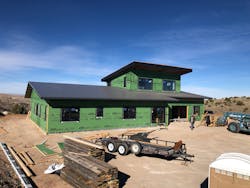Solar Decathlon 2023 Build & Design Challenge Winners Announced
The winners of the U.S. Department of Energy Solar Decathlon 2023 Build and Design challenges were announced at the hybrid Solar Decathlon Competition Event, April 20–23 at the National Renewable Energy Laboratory in Golden, Colorado. The overall winners for the 2023 Build Challenge are Ball State University in first place; Indian Institute of Technology (IIT) Bombay took second; and The University of British Columbia (UBC) took third.
Since the first Solar Decathlon Build Challenge in 2002, more than 25,000 students have constructed efficient, affordable buildings powered by renewables, while promoting student innovation, STEM education and workforce development opportunities in the buildings industry. Solar Decathlon founder Richard King conceived the notion in 2000. He served as director until his retirement in 2015. The inaugural event two years later had 60 students; more recent competitions have attracted upwards of 1,000. Students have two years to design and construct a building.
Current Solar Decathlon director Holly Carr said the event has evolved to include a Design Challenge in 2018 and a local build event because of the pandemic. Historically, the buildings were transported to and displayed on the National Mall. It seemed antithetical to ask teams to construct buildings and then transport them to the competition, she added, so the switch to all-local builds made sense.
“We were going to have an optional build-in-place pathway event in 2020 and because of COVID, it became a local build event,” Carr said. “It became a practice run to move to an all-local build event, which we have fully transitioned to for this 2023 competition year.”
The shift also makes the competition more accessible and reduces the cost to schools to compete, she said. However, the focus on zero energy renewable elements remains a central component to the decathlon.
10 Contests, One Goal: Saving Energy
This year’s decathlon scores teams on 10 contests:
- Architecture
- Engineering
- Market Analysis
- Resilience
- Embodied Environmental Impact
- Integrated Performance
- Occupant Experience
- Comfort and Indoor Environmental Quality
- Energy Performance
- Presentation
Embodied environmental impact, the newest contest, analyzes life cycle carbon and resource use in the houses: How much energy is used in the house, how much energy is used to pull resources out of the ground and transport goods to the house and how much energy does it take to construct and deconstruct?
The 2023 Build Challenge contest winners are UBC in the architecture contest; University of Waterloo, engineering; University of Illinois Urbana-Champaign, market analysis; University of Colorado Boulder, durability and resilience; UBC, embodied environmental impact; IIT, integrated performance; Ball State University, UBC, IIT, and University of Wyoming (UW), occupant experience; UW, comfort and environmental quality; Ball State University, University of Kansas and UW, energy performance; and University of Illinois Urbana-Champaign, presentation.
Finalists showed innovative designs in concrete dome construction, 3D-printed concrete designs, hydrogen energy storage, frost protective foundation systems, and ground contact wood foundation. Other innovations included heat pump, lighting and home energy management technologies.
Each contest is worth a maximum of 100 points, for a potential competition total of 1,000 points. The top three Build Challenge teams heading into the hybrid event in Colorado were Ball State University in first with 299.88 points, UBC in second with 298.28 points and UW in third with 291.11 points.
Energy performance results for the houses as of April 21 changed the top teams to Ball State University with 379.88 points, University of Wyoming with 371.11 points, and Kansas University with 364.57 points. Final scores awarded Ball State University the top prize with 847.82 points, Indian Institute of Technology Bombay second with 846.58 points and UBC third with 824.28 points. The projects incorporate off-the-shelf technologies as well as special apps.
Low Carbon by Design
The UBC team Third Quadrant Design previously won the Solar Decathlon design challenge in 2020 and 2021, so it was confident in focusing on the design principle of low carbon.
“We pitched the idea of a low carbon build project on campus to the leadership at UBC Faculty of Applied Science,” faculty adviser Lou Corpuz-Bosshart shared on behalf of his students. “Ultimately, we learned that the pathway to net-zero is simpler than we often think. This building, in the end, did not rely on very complex engineering systems to get it to nearly zero-energy design.”
The building achieved a 65% reduction in embodied carbon, produces zero carbon emissions in operation and is actively sequestering carbon years ahead of schedule. The team performed an iterative life cycle analysis to validate its methodology.
Building systems (lights, solar, HVAC) are interconnected wirelessly and controlled by an IoT-ready building management system. The passive design features thick, well-insulated walls, windows and skylights that can open to regulate temperature and white walls and roof to minimize solar heat gain.
Third Quadrant Design took advantage of the region’s renewable grid and minimizes carbon through adaptive reuse of construction waste materials, low carbon material swaps and carbon sequestration.
The UW's team constructed a three-bedroom, two-and-a-half-bath house from materials readily available on the market and followed a building plan that is repeatable.
University of Wyoming student team lead and structural engineering student Alison Carlo said, “The goal of our home from the beginning was to create a project that hid all the systems that made our home function. This made our team focus on systems that were quieter or rearrange our floor plan slightly to better hide our mechanical room, while keeping the functionality.”
Smart systems and controls are integrated throughout the house, offering customization by the person while ensuring some systems operate as intended.
“During our open house we had so many people who asked us how they could apply these to their new build or future home plans, and it was great to respond with, ‘You can do all of this,’” Carlo explained.
Teammate Erika Ferrell learned about the simple solutions to achieve zero energy design and technologies.
“Simply by paying attention to the shape and placement of your home can cut energy cost and usage,” she said. “Another thing that I learned is that using energy efficient equipment, although initially may be more expensive, pays for itself in the long run.”
The house uses active and passive solar strategies, energy efficient fixtures and appliances to support sustainable living. A monitoring system tracks energy usage and the lighting and temperature controls put the occupant at the helm.
Use Cases for the Real World
The Design Challenge takes six to 12 months to complete and does not involve construction. Fifty-seven teams from 63 institutions entered the final stage of the Design Challenge after teams presented their zero energy building designs to a panel in late February. Projects were submitted into six divisions: new housing, retrofit housing, attached housing, multifamily building, office building and education building.
“We really encourage our design challenge teams to work with industry partners—a developer or building owner on a real building,” Carr explained. “They’re looking at a real use case, a real property and real location to design or renovate that space.”
The 2023 Design Challenge grand winners are University of Minnesota Twin Cities in the residential category; and The Cooper Union for the Advancement of Science and Art, in commercial. Division winners include University of Florida, new housing; Appalachian State University, retrofit housing; University of Minnesota Twin Cities, attached housing; Virginia Polytechnic Institute and State University, multifamily; Wentworth Institute of Technology, office building; and The Cooper Union for education building.
Scores and more information about this year’s Solar Decathlon are available online at solardecathlon.gov.
About the Author
Lauren Brant
Buildings Editor
Lauren Brant is the editor of Buildings. She is an award-winning editor and reporter whose work appeared in daily and weekly newspapers. She strives to create content that is informative and actionable for professionals, helping them discover new products, technology, and insights to make smarter building decisions. In 2020, the weekly newspaper won the Rhoades Family Weekly Print Sweepstakes—the division winner across the state's weekly newspapers. Lauren was also awarded the top feature photo across Class A papers. She holds a B.A. in journalism and media communications from Colorado State University-Fort Collins and a M.S. in organizational management from Chadron State College.

